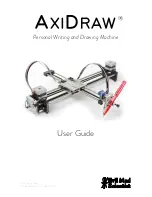
14
8: Pens and Getting Ready for Printing
In this section we will discuss different types of pens, configuring the pen to be vertical or
at an angle, the pen-up and pen-down positions, setting the pen height, and how to set
the paper position relative to the pen.
8.1 Pen choices
The pen holder on the fits pens up to ⅝ inch (16 mm) in diameter. The maximum recom-
mended pen weight is 1.6 oz (45 g). The design is such that the pen rests on the surface by
its own weight. That allows it to ride over surfaces that are textured or otherwise uneven,
however it also means that the pen holder does not apply significant downward pressure.
Good choices for pens to use include fountain pens, permanent markers, rollerball pens,
technical pens, (small-bodied) whiteboard markers, liquid chalk markers, and other writing
and drawing instruments that do not require significant downward pressure. While we will
refer to writing and drawing instruments as “pens” to be concise, other instruments such
as automatic pencils, chalk, charcoal, and brushes can also work well in many cases.
Ball point pens (and perhaps certain other writing instruments) may work inconsistently
because they require a substantial amount of downward pressure to operate.
8.2 Setting the pen angle
The pen may be mounted vertically or diagonally at 45° to the paper by mounting the Pen
Clip in either the vertical or angled position.
To detach the pen clip, loosen and remove the two black M3 screws on the front of the
pen clip, using the 5/64” (2 mm) hex wrench, which has a ball end for easy access. Use
the same two screws to reattach the pen clip, either in the vertical or diagonal orientation.
The 45° angle position is optimal for use with fountain pens, but will work well with most
rollerball and fine point markers. The vertical position is more suited to markers with fatter
tips or writing instruments that require more downward pressure.





























